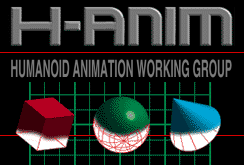Humanoids Among Us
Dateline: 10/27/97
 People,
people where are the people! VRML worlds are, by and large, desolate places.
Sure there are a few robots, a few birds flapping their wings but I want
to see people. Apparently so do a lot of other folks! The VRML
Humanoid Animation Working Group is working on the H-Anim
spec to solve this shortcoming.
People,
people where are the people! VRML worlds are, by and large, desolate places.
Sure there are a few robots, a few birds flapping their wings but I want
to see people. Apparently so do a lot of other folks! The VRML
Humanoid Animation Working Group is working on the H-Anim
spec to solve this shortcoming.
Led by Bernie Roehl,
Cindy Reed-Ballreich, Mitra
(the only person I know in real life with one name) and other notable
VRML luminaries the H-Anim spec focuses specifically on the definition
and interoperability of virtual humans. A key aspect is that the H-Anim
spec let's you model a humanoid using the existing VRML 2.0 mechanisms.
NO VRML EXTENSIONS are necessary.
The spec itself consists of the definition of several "PROTOS" (a proto
is the VRML 2.0 way to create a new node) for such humanoid items as, Joints,
Body Parts (Segments in H-Anim speak), and a top level node imaginatively
called "Humanoid". The Joints are arranged within a hierarchy, like (let's
all sing now) the foot bone's connected to the leg bone, the leg bone's
connected to the thigh bone...and so on.
In keeping with the desired goal of interoperable humans the h-anim
group has taken many concepts from the SNHC (Synthetic Natural Human Coding)
group of the MPEG (Motion Picture
Experts Group) international standards effort. The format for encoding
video on those new DVD discs was developed by these folks and the idea
is to have virtual humans represent real people (avatars) for virtual meetings
and conferences with reasonable networking bandwidth requirements.
That about covers it. The next time you see some VRML worlds with people
inside doing <fill-in-the-blank-with-favorite-human-activity-here> ask
if it's h-anim compliant and if not why!
Previous
Features
 People,
people where are the people! VRML worlds are, by and large, desolate places.
Sure there are a few robots, a few birds flapping their wings but I want
to see people. Apparently so do a lot of other folks! The VRML
Humanoid Animation Working Group is working on the H-Anim
spec to solve this shortcoming.
People,
people where are the people! VRML worlds are, by and large, desolate places.
Sure there are a few robots, a few birds flapping their wings but I want
to see people. Apparently so do a lot of other folks! The VRML
Humanoid Animation Working Group is working on the H-Anim
spec to solve this shortcoming.